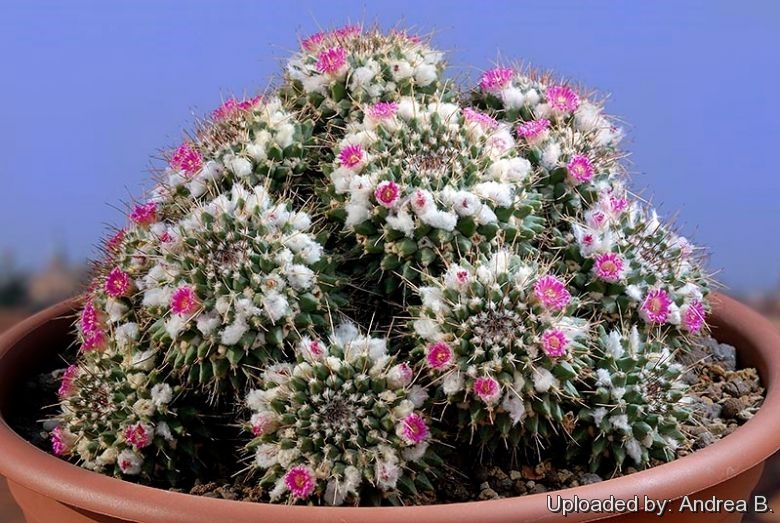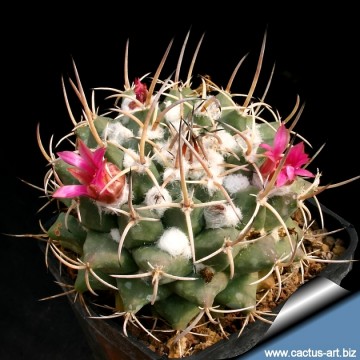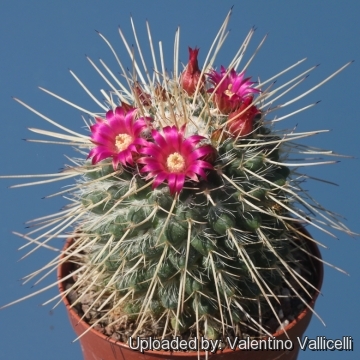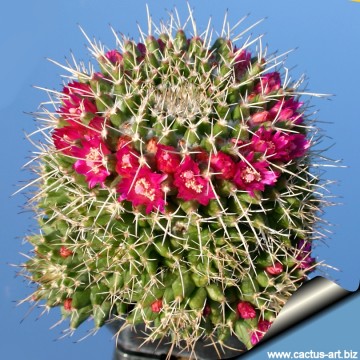Accepted Scientific Name: Mammillaria compressa DC.
Mém. Mus. Hist. Nat. xvii. (1828) 112.

Cactus compressus (Mammillaria compressa) Photo by: Andrea B.
Easily clustering and easily flowered it is one of the largest of all the Mammillarias. Most plants will offset readily, and huge clumps can be produced in a very few years.
Origin and Habitat: Mammillaria compressaSN|11897]]SN|11897]] (and ssp. centralifera) grows and is locally abundant in central Mexico (Hidalgo, Queretaro, Guanajuato, Tamaulipas, Nuevo León and San Luis Potosi)
Altitude: Grows at an altitude of 1000-2240 metres above sea level.
Habitat: This species occurs in matorral crascicaule. There are 16 recognized subpopulations and there are no major threats to this species, however some subpopulations are impacted by the extraction of wild specimens for commercial purposes. The habitat of Mammillaria compressaSN|11897]]SN|11897]] is home to succulent flora and is particularly rich in local endemics such as: Thelocactus leucacanthusSN|1067]]SN|1067]], Echinocereus cinerascensSN|7775]]SN|7775]], Marginatocereus marginatusSN|8045]]SN|8045]],
Synonyms:
See all synonyms of Mammillaria compressa
Common Names include:
RUSSIAN (Русский): Маммиллярия плоская
SWEDISH (Svenska): Syskonvårtkaktus
UKRAINIAN (Українська): Мамілярія компреса, Мамілярія стиснута
Description: Globular cactus, solitary at first, later forming massive clumps to 1 m wide.
Stems: Club shaped to cylindrical, bluish grey-green, up to 10 cm in diameter, up to 25 cm tall. With latex. Tubercles are prominent, close set, firm, bluntly angled and keeled. The Axil bears white wool and bristles.
Central spines: Usually absent.
Radial spines: 4-6, unequal, chalky white with brownish tips, 20-70 mm long, some very short.
Flowers: Bell shaped, purplish pink to deep red, 1-1,5 cm in diameter.
Blooming season: Winter, early spring.
Fruits: Club shaped, red.
Seeds: Brown.
Subspecies, varieties, forms and cultivars of plants belonging to the Mammillaria compressa group
 Mammillaria compressa DC.: (subsp. compressa) forms up to 1 m wide in a very few years. It has no central spines. Distribution: Hidalgo and Queretaro, Mexico.
Mammillaria compressa DC.: (subsp. compressa) forms up to 1 m wide in a very few years. It has no central spines. Distribution: Hidalgo and Queretaro, Mexico. Mammillaria compressa f. bernalensis (Repp.): has rudimentary radial spines and 3-5 central spines (usually missing in standard Mammillaria compressa). Distribution: San Pablo Toliman, Bernal, Querétaro, Mexico
Mammillaria compressa f. bernalensis (Repp.): has rudimentary radial spines and 3-5 central spines (usually missing in standard Mammillaria compressa). Distribution: San Pablo Toliman, Bernal, Querétaro, Mexico Mammillaria compressa subs. centralifera (Repp.) D.R.Hunt: It often has solitary stems but is sometimes clumping and has 2 central spines. Distribution: Queretaro, Tamaulipas, and San Luis Potosi.
Mammillaria compressa subs. centralifera (Repp.) D.R.Hunt: It often has solitary stems but is sometimes clumping and has 2 central spines. Distribution: Queretaro, Tamaulipas, and San Luis Potosi. Mammillaria compressa f. cristata: It develops huge brain-shaped hemispherical mounds up to 1 m in diameter. There are several different crested clones.
Mammillaria compressa f. cristata: It develops huge brain-shaped hemispherical mounds up to 1 m in diameter. There are several different crested clones. Mammillaria compressa cv. Yokan: This strange Mammillaria makes a nice and tangled cluster of fine crests. Brownish-green or purple in full sun exposure with fine soft white spines.
Mammillaria compressa cv. Yokan: This strange Mammillaria makes a nice and tangled cluster of fine crests. Brownish-green or purple in full sun exposure with fine soft white spines. Mammillaria tolimensis R.T.Craig: Stem up to 10 cm across, grey to yellowish green and forming suckers. Spines creamy-white to 5-6 cm long. Distribution: Santa María del Mexicano, between Bernal and Toliman, QRO, Mexico.
Mammillaria tolimensis R.T.Craig: Stem up to 10 cm across, grey to yellowish green and forming suckers. Spines creamy-white to 5-6 cm long. Distribution: Santa María del Mexicano, between Bernal and Toliman, QRO, Mexico.
Bibliography: Major references and further lectures
1) Edward Anderson “The Cactus family” Timber Press, Incorporated, 2001.
2) James Cullen, Sabina G. Knees, H. Suzanne Cubey "The European Garden Flora Flowering Plants: A Manual for the Identification of Plants Cultivated in Europe, Both Out-of-Doors and Under Glass" Cambridge University Press, 11/Aug/2011.
2) David R Hunt; Nigel P Taylor; Graham Charles; International Cactaceae Systematics Group. "The New Cactus Lexicon" dh books, 2006.
3) John Pilbeam “Mammillaria: the cactus file handbook” Cirio Publishing Services Ltd Dec/30/1999.
4) Guadalupe Martínez, J., Sánchez , E. & Bárcenas Luna, R. 2013. Mammillaria compressa. In: IUCN 2013. "IUCN Red List of Threatened Species." Version 2013.2. <www.iucnredlist.org>. Downloaded on 08 January 2014.
 Cactus compressus (Mammillaria compressa) Photo by: Cactus Art
Cactus compressus (Mammillaria compressa) Photo by: Cactus Art Ecotype from Coronel, San Luis Potosi, Mexico. (Mammillaria compressa) Photo by: Valentino Vallicelli
Ecotype from Coronel, San Luis Potosi, Mexico. (Mammillaria compressa) Photo by: Valentino Vallicelli Cactus compressus (Mammillaria compressa) Photo by: Cactus Art
Cactus compressus (Mammillaria compressa) Photo by: Cactus Art Cactus compressus (Mammillaria compressa) Photo by: Valentino Vallicelli
Cactus compressus (Mammillaria compressa) Photo by: Valentino Vallicelli Cactus compressus (Mammillaria compressa) Photo by: Cactus Art
Cactus compressus (Mammillaria compressa) Photo by: Cactus ArtSend a photo of this plant.The gallery now contains thousands of pictures, however it is possible to do even more. We are, of course, seeking photos of species not yet shown in the gallery but not only that, we are also looking for better pictures than those already present.
Read More... Cultivation and Propagation: Mammillaria compressa is an easy to grow species, just as a classic cactus, don't requires any special treatment, that seems to enjoy, in cultivation, good root space, and well drained compost, though it is not a quick grower. It is a great plant for the cactus grower, that readily builds up into a cluster of stems highlighted by dense spines, further decorated by rings of pink blooms.
Growth rate: It is a rapid growing species that will form large clumps rather rapidly when compared to other Mammillaria species. Most plants will offset readily, and clumps can be produced in a few years. It will fill a large pot or pan in time however, so space is needed if it is to show of its best..
Soils: It likes very porous standard cactus mix soil with little organic matter (peat, humus).
Repotting: Repotting every 2-3 years. Needs lots and lots of space to grow, use large shallow
container or bowl filled with very porous compost. Use pot with good drainage.
Watering: Water regularly in summer, but do not overwater (very wet-sensitively). Its roots are easily lost in pots that stay damp for any length of time. Keep dry with ample airflow in winter. In the rest period no high atmospheric humidity!! Care must be taken with watering as they tends to become swollen and untidy in growth habit if given too much water and shade.
Fertilization: During the growing season enrich the soil using a fertilizer rich in potassium and phosphorous, but poor in nitrogen, because this chemical element doesn’t help the development of succulent plants, making them too soft and full of water.
Hardiness: It is quite frost resistant if kept dry, hardy as low as -5° C (some reports give it hardy to -12°C). However some warmth throughout the year will increase the grower's success (minimum 5° to 8°C during rest season).
Exposition: Outside bright sun, filtered sunlight or afternoon shade, inside it needs bright light, and some direct sun. Subject to sunburn if exposed to direct sun for too long. Tends to bronze in strong light, which encourages flowering and heavy spine production.
Uses: It is an excellent plant for container growing. It always looks good and stays small. It look fine in a cold greenhouse and frame.
Traditional uses: The white, hooked spines of this spherical cactus were used as fish hooks in its native Mexico.
Pests & diseases: It may be attractive to a variety of insects, but plants in good condition should be nearly pest-free, particularly if they are grown in a mineral potting-mix, with good exposure and ventilation. Nonetheless, there are several pests to watch for:
- Red spiders: Sensitive to red spider mite. Overhead watering is helpful in controlling mites.
- Mealy bugs: Occasionally mealy bugs they develop aerial into the new growth among the wool with disfiguring results, but the worst types develop underground on the roots and are invisible except by their effects.
- Scales: Scales are rarely a problem.
- Rot: Rot it is only a minor problem with cacti if the plants are watered and “aired” correctly. If they are not, fungicides won't help all that much.
Propagation: By division, or direct sow after last frost. Seeds germinate in 7-14 days at 21-27° C in spring, remove the glass cover gradually as the plants develops and keep ventilated, no full sun for young plants! The seedlings should not be disturbed until they are well rooted, after which they can be planted separately in small pots. Cuttings: wait until the offsets that appear at the base of old clustered specimens are 1/3 the size of the parent and then detach and plant. Cuttings will take root in a minimum temperature of 20° C (but better in hot weather). Cuttings of healthy shoots can be taken in the spring and summer. Cut the stem with a sharp, sterile knife, leave the cutting in a warm, dry place for a week or weeks (depending on how thick the cutting is) until a callus forms over the wound. Once the callus forms, the cutting may be inserted in a container filled with firmed cactus potting mix topped with a surface layer of coarse grit. They should be placed in the coarse grit only; this prevents the cut end from becoming too wet and allows the roots to penetrate the rich compost underneath. The cuttings should root in 2 to 6 weeks.















